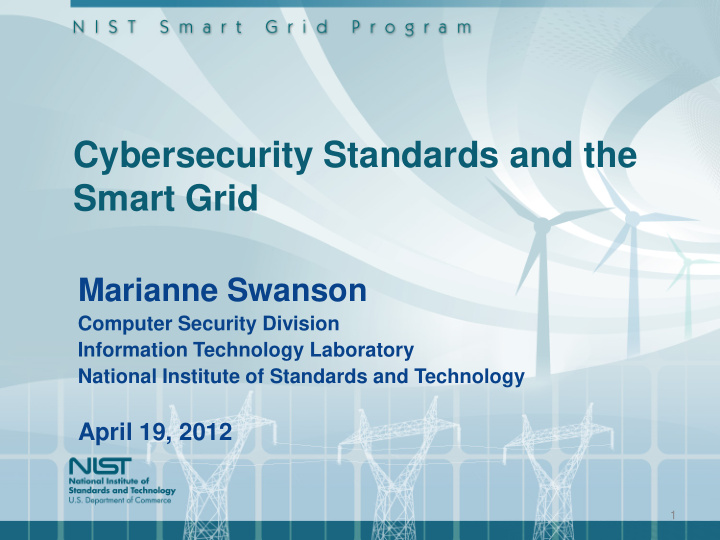



Cybersecurity Standards and the Smart Grid Marianne Swanson Computer Security Division Information Technology Laboratory National Institute of Standards and Technology April 19, 2012 1
Cyber Security Working Group (CSWG) Background • To address the cross-cutting issue of cybersecurity, NIST established the Cyber Security Coordination Task Group (CSCTG) in March 2009. • Moved under the NIST Smart Grid Interoperability Panel (SGIP) as a standing working group and was renamed the Cyber Security Working Group (SGIP–CSWG). • The CSWG now has more than 700 participants from the private sector (including vendors and service providers), academia, regulatory organizations, national research laboratories, and federal agencies. 2
Guidelines for Smart Grid Cyber Security NIST Interagency Report 7628 - August 2010 • Development of the document lead by NIST • Represents significant coordination among – Federal agencies – Private sector – Regulators – Academics 3
Recent Accomplishments - 1 • SGIP Priority Action Plan (PAP) collaboration • Ongoing outreach and education efforts – 8 States (4 PUCs) – Over 1,000 participants – One page brochure – Privacy briefing for utilities and public utility commissions • Developing a NISTIR 7628 High Level Requirements Assessment Guide • Collaborated with DOE and NERC to develop a harmonized electricity sector enterprise-wide risk management process 4
Recent Accomplishments - 2 • CSWG/DOE’s NESCOR collaboration on Smart Energy Profile (SEP) 1.0 and 1.1 technical white paper • Cybersecurity Review of Standards – Over 25 reviews of standards or PAP deliverable requirements • 5 IEC Common Information Model Standards • ZigBee SEP 1.0, 1.1, and Draft SEP 2.0 • ANSI C12 Suite • IEC 1815 (DNP3) and IEC 1815.1 (Mapping between DNP3 and IEC 61850) • White Paper on Automating Smart Grid Security • NERC CIP v5 mapping to NISTIR 7628 • Mapping and analysis between NISTIR 7628 and the Smart Meter Gateway Protection Profile
Cyber-Physical Attacks - Collaboration • The CSWG will provide cybersecurity expertise to help address cyber-physical threats in coordination with other federal agencies and industry groups. – Workshop on April 23 – 24, 2012 in Gaithersburg, MD • The collaborative effort will result in: – NISTIR 7628 high-level security requirements being augmented to address cyber-physical security threats. – NISTIR on workshop proceedings. – Identification of future work/collaboration in this area. 7
Proposed Work for 2013 and Beyond - 1 • Security Content Automation Protocol (SCAP) extension to cover cyber-physical systems – Provide a standardized, measureable, automated method of continuous monitoring for Smart Grid components, increasing efficiency and accuracy, reducing costs of secure implementations, and improving capability and interoperability of implementations. • Research in lightweight, low-power cryptography – Enabling encryption for millions of smart meters and other devices for the Smart Grid with limited computational power. 8
Proposed Work for 2013 and Beyond - 2 • Identity management – Helping to ensure the security of customer information when dealing with utilities and third parties; enabling remote authentication on anonymous devices.
Learning More and Getting Involved • Learn more about the CSWG at: http://collaborate.nist.gov/twiki- sggrid/bin/view/SmartGrid/CyberSecurityCTG • Learn more about the subgroups, including meeting times: http://collaborate.nist.gov/twiki- sggrid/bin/view/SmartGrid/WorkingGroupInfo • To join the CSWG and any of the subgroups, send your name, affiliation, and which lists you wish to join to: tanya.brewer@nist.gov and marianne.swanson@nist.gov • Download NISTIR 7628 at: http://csrc.nist.gov/publications/PubsNISTIRs.html#NIST-IR-7628 10
Recommend
More recommend